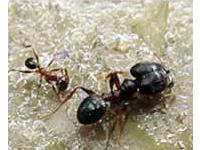- Know Your Pests
- Ant – Spiny Harvester Ant or Big headed Ant
Ant – Spiny Harvester Ant or Big headed Ant
Confused Flour Beetle (Also see Rust-Red Flour Beetle)
Granary Weevil (Also see Rice Weevil)
Mediterranean Flour Moth or Mill Moth
Red-legged Ham or Copra Beetle
Rice Weevil (Also see Granary Weevil)
Rust-Red Flour Beetle (Also see Confused Flour Beetle)
Tropical Warehouse or Almond Moth (Also see Warehouse, Tobacco or Cocoa Moth)
Warehouse, Tobacco or Cocoa Moth (Also see Tropical Warehouse or Almond Moth)

Appearance
Major workers with large heads (with the back of the head being heart-shaped) and mandibles, 4mm long, reddish-brown with brown gaster; minor workers, 1.5mm long, pale yellow to brown with darker head and gaster; two nodes and two propodeal spines; polymorphic, with major and minor workers.
Notes
Colonies are small, with around 200-300 members. A terrestrial ant, often making nests in wall-floor junction and cracks on floors and walls. Nest entrance is cleared and soil particles placed about 3-5cms away from it. Trails are formed readily, but usually not far away from the nest. The ant prefers seeds and insects but will readily feed on honeydew and sugary substances. Indoors, the ants forage for high-protein foods such as meats, molasses, peanut butter, pet food, cereals, etc.

